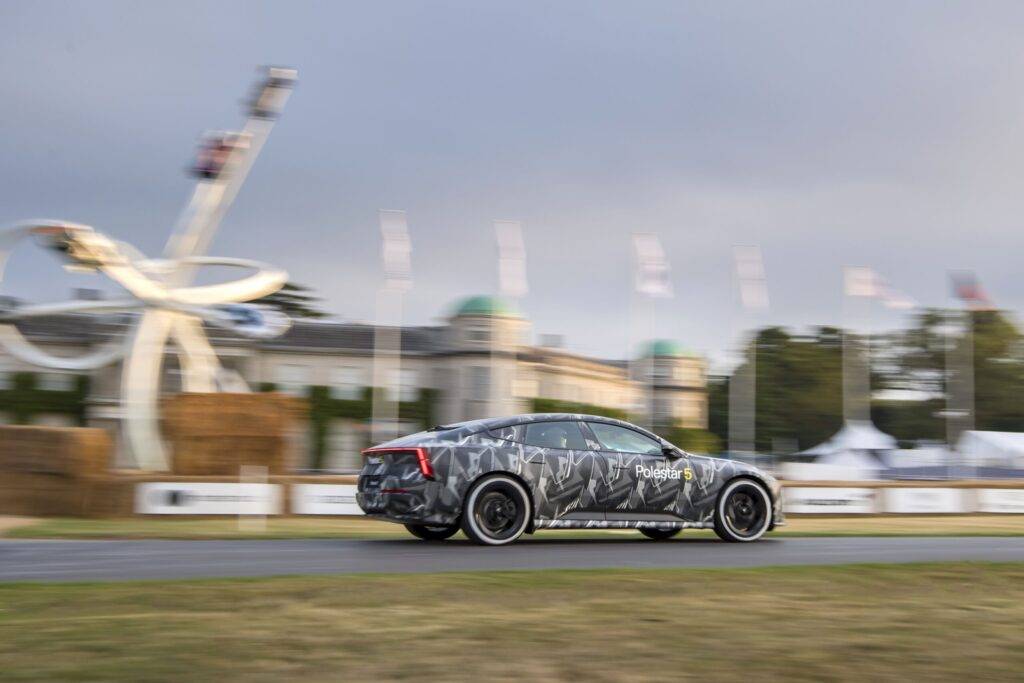Porsche, be prepared! Polestar, the Swedish automotive brand, is laboring diligently on a formidable competitor to your electric marvel, the Taycan. They’re sculpting an imposing, all-electric four-door GT based on an entirely fresh bonded aluminum platform that promises to raise eyebrows and pulse rates.
The tale unfolds in Nuneaton, England, within the confines of Polestar’s UK research and development center, which is situated at the Motor Industry Research Association’s proving grounds just outside Coventry. The facility was buzzing with the anticipation of Polestar’s next thrilling venture into electric automobiles, christened as the Polestar 5.
In the past, Polestar electric vehicles have primarily been assembled on platforms borrowed from other Geely group brands. For instance, the Polestar 2 fastback sedan shares the CMA platform with the Volvo XC40. Likewise, the upcoming Polestar 3 SUV, which is set to roll out next year from South Carolina, will utilize the group’s SPA2 platform.
However, building on shared platforms has its limitations. They are primarily conceived for high volume production, where qualities like a comfortable ride supersede dynamic handling capabilities. This approach works quite well for luxury SUVs, but when it comes to crafting a contender for the Porsche Taycan, it’s prudent to commence from scratch.
This is exactly the path Polestar has taken with the Polestar 5, which is a physical embodiment of the visionary Precept concept unveiled back in 2020. It has been engineered with a bonded and extruded aluminum chassis akin to the ones in Lotus and Aston Martin. This kind of construction is better suited to limited volume production, and the resulting structure is extremely rigid due to the larger and stronger bonded joints compared to conventional welding.
There’s more than just a new chassis. Pete Allen, head of Polestar UK R&D, noted that achieving the striking low nose and graceful lines of the Polestar 5, while maintaining high-performance dynamics and comfort, required an entirely new suspension system. Fitting large 21-inch wheels while keeping the car’s front low would have been a pipe dream on Geely group’s SPA2 platform.
Visually, the Polestar 5 cuts an impressive figure. Behind the giant wheels, you’ll find substantial brake discs that, combined with regenerative braking, promise rapid deceleration. While we were touring the facility, Polestar’s engineers were working on several Polestar 5 prototypes, all camouflaged and at different stages of development.
It’s hard to avoid comparisons with Porsche’s Taycan. Both have battery packs with specific voids, colloquially known as foot garages, to accommodate rear seat passengers’ feet. This arrangement helps to keep the rear seat low and provides ample space for adults without sacrificing the car’s low roofline.
While the Taycan maintains a rear window, the Polestar 5 opts for a camera system for rear visibility, akin to what you might find in a Chevrolet Bolt or Corvette. This comes in addition to conventional side mirrors. The car is designed to handle well, with most of its British development team hailing from Lotus and McLaren.
What’s surprising is the simplicity of the car’s suspension. Polestar has avoided air suspension, active anti-roll bars, or rear-wheel steering, instead opting for passive springs and dampers. Steve Swift, head of vehicle engineering at Polestar, believes that a well-tuned ride can be enhanced for handling, but the reverse isn’t quite as achievable.
The Polestar 5 is anticipated in both single and dual motor versions. The former uses a newly designed Polestar motor and drive unit, while the latter adds a front motor, similar to the one in the Polestar 2. The estimated total power and torque for the dual motor variant is around 871 hp and 664 lb-ft respectively.
Although a full verdict must wait until the completed Polestar 5 makes its debut, early impressions from the development process inspire optimism. Brace yourselves, the electrifying rivalry is only just heating up.

